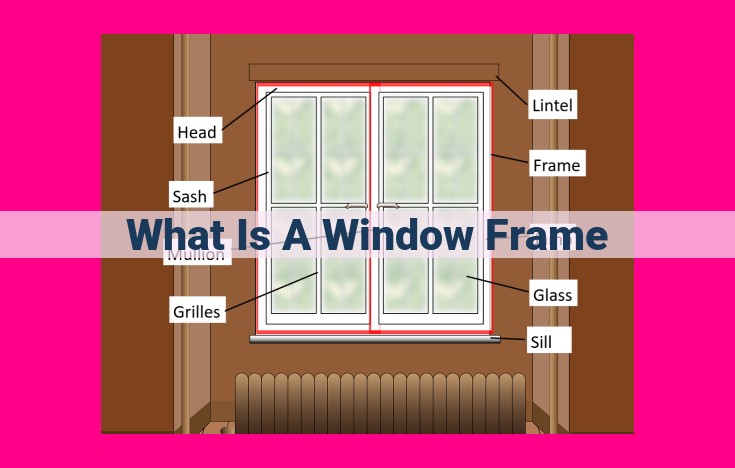Understanding Window Frame Components: Essential Guide For Structural Security

The window frame is the structural element that holds the window in place and provides a secure opening in the wall. It consists of the head or top horizontal member, the jambs or side vertical members, and the sill or bottom horizontal member. Additionally, the sash, which holds the glass panes, and the trim, which covers the gaps between the frame and the wall, are crucial components of a window.
Components of a Window
Windows, the portals to the outside world, are intricate assemblies of various components that work together to provide functionality, insulation, and aesthetic appeal to a building. Understanding these components is crucial for informed decision-making when choosing and maintaining windows.
Head:
The head of a window frames the top of the opening. It supports the weight of the other window components and prevents water from seeping into the structure. Typically made of sturdy materials like wood or metal, the head is often hidden by trim or molding for a seamless appearance.
Jamb:
The side frames of a window are called jambs. They define the width of the opening and support the sash (the movable part) that holds the glass. Jambs ensure proper alignment and thermal insulation, preventing drafts and heat loss.
Sill:
The sill is the horizontal member at the bottom of a window. It supports the sash and directs water away from the building. Sills are typically sloped to prevent water accumulation and subsequent damage. Materials used for sills include wood, stone, and vinyl, depending on durability and aesthetic preferences.
Sash:
The sash is the operable part of a window that houses the glass. It can slide vertically, horizontally, or pivot, providing ventilation and access to the outdoors. Sashes are made of various materials, including wood, vinyl, and aluminum, and can be single-paned or double-paned for increased energy efficiency.
Trim:
The trim of a window serves both aesthetic and functional purposes. It covers gaps between the window and the surrounding wall, enhancing the overall appearance and preventing water infiltration. Trim is typically made of wood or vinyl and can be painted or stained to match the interior or exterior décor.
Types of Windows: A Comprehensive Guide to Enhance Your Home’s Style and Functionality
Windows, the translucent portals of your home, not only frame breathtaking views but also play a crucial role in ventilation, insulation, and energy efficiency. Understanding the various types of windows available can help you make an informed decision that aligns with your architectural style, functional needs, and personal preferences.
Single-Hung Windows: Simplicity and Affordability
Single-hung windows feature one movable sash that slides vertically within a fixed upper sash. Their simplicity of design makes them a budget-friendly option while offering adequate ventilation. However, their limited opening range may be a drawback for areas requiring more airflow.
Double-Hung Windows: Classic Refinement with Enhanced Ventilation
Double-hung windows offer a similar aesthetic to single-hung counterparts, but with the added benefit of two sashes that slide independently. This increased flexibility allows for controlled ventilation, as you can open only the top or bottom sash as needed. Their timeless design and adaptability make double-hung windows a versatile choice for any home.
Horizontal Slider Windows: Sleek and Convenient
Horizontal slider windows feature two sashes that glide horizontally, providing a smooth and effortless operation. Their large glass panes maximize natural light and create a spacious feel. Slider windows are ideal for modern homes, offering a contemporary touch and easy access to fresh air.
Casement Windows: Wide-Open Ventilation and Energy Efficiency
Casement windows are hinged on one side, allowing them to open outward like a door. This design provides excellent ventilation and a clear, unobstructed view. Casement windows are also known for their energy efficiency, as they create a tight seal when closed. Their classic style complements both traditional and modern homes.
Awning Windows: Sheltered Ventilation and Weather Protection
Similar to casement windows, awning windows hinge at the top, but they open outward from the bottom. This unique design offers protection from rain and wind while still allowing for fresh air circulation. Awning windows are commonly used in basements, bathrooms, and kitchens, where privacy and weather resistance are important.
Picture Windows: Uninterrupted Views and Natural Light
Picture windows are fixed units that offer expansive, unobstructed views. With their large glass panes and minimal framing, picture windows maximize natural light and create a sense of spaciousness. While they do not provide ventilation, their aesthetic appeal makes them a stunning focal point for any room.
Making the Right Choice: Consider Your Needs and Style
Choosing the right type of window for your home depends on a combination of factors, including ventilation needs, energy efficiency goals, architectural style, and personal preferences. Single-hung and double-hung windows are good all-around options, while slider windows provide convenience and modern appeal. Casement and awning windows excel in ventilation, with casement windows offering a classic aesthetic and awning windows providing weather protection. Picture windows are ideal for maximizing natural light and creating a sense of grandeur. By understanding the different types of windows available, you can select the perfect fit for your home, enhancing its style, functionality, and overall comfort.
The Vital Role of Windows: Ventilation, Insulation, and Comfort
Windows are often overlooked in home design, but they play a crucial role in ensuring comfort and energy efficiency. Let’s delve into the ways windows contribute to a healthier and more sustainable living space:
Ventilation
Windows provide essential ventilation, allowing fresh air to flow into your home. This is vital for maintaining indoor air quality, as it removes stale air, pollutants, and excess moisture. Proper ventilation also helps prevent the buildup of harmful mold and mildew, creating a healthier environment for you and your family.
Insulation
Modern windows are designed with energy efficiency in mind. They feature double or triple glazing, which creates an insulating layer that helps trap heat in winter and keep the cold out in summer. High-quality windows can significantly reduce heat loss and lower your energy bills.
Daylight
Windows are a natural source of daylight, which has numerous benefits for our well-being. Daylight helps regulate our circadian rhythm, making us more alert and productive during the day and promoting better sleep at night. It also improves our mood and cognitive function, creating a more positive and inviting atmosphere in your home.
Windows as Architectural Elements
Beyond their functional roles, windows can also enhance the architectural style of a building. The shape, size, and color of windows can complement the overall aesthetic, adding visual interest and curb appeal. From traditional casement windows to modern picture windows, a carefully chosen window design can elevate the architectural character of your home.
In conclusion, windows are not just openings in a wall. They play a vital role in maintaining a healthy and comfortable living environment while also contributing to energy efficiency and architectural style. By understanding the functionality of windows, you can make informed decisions when selecting and designing them for your home.
Design Elements of Windows: Enhancing Aesthetics and Architectural Harmony
Windows, serving as portals between indoor and outdoor spaces, transcend their functional role to become integral design elements in any architectural endeavor. Their shape, size, and color, like the brushstrokes of a master painter, contribute significantly to the overall aesthetic appeal of a building.
Shape: A Symphony of Geometric Expressions
From the classic rectangular shape to the more contemporary arched or circular designs, the shape of a window can profoundly influence the ambiance it creates. Rectangular windows exude a sense of order and balance, while arched windows evoke a touch of elegance and grandeur. Circular windows, with their soft and flowing lines, bring a sense of warmth and playfulness to a space.
Size: Balancing Light and Privacy
The size of a window plays a crucial role in determining the amount of natural light that enters a room. Large windows, while inviting abundant sunlight, can also compromise privacy. Smaller windows offer more privacy but may limit natural light. Finding the optimal balance between these factors is essential for creating a comfortable and inviting interior.
Color: A Vibrant Palette for Architectural Statements
The color of a window can have a transformative effect on the overall appearance of a building. Neutral colors, such as white or black, seamlessly blend with any architectural style, offering a timeless appeal. Bold colors, on the other hand, can create striking visual accents, drawing attention to specific areas of the facade. When choosing a color, consider the architectural style of the building and the overall color scheme to ensure a harmonious aesthetic.
Complementing Architectural Styles: A Harmonious Tapestry
The design elements of windows should complement the architectural style of a building to create a unified and aesthetically pleasing whole. For traditional architectural styles, such as Tudor or Georgian, large, rectangular windows with distinct muntins enhance the historic character. Modern architectural styles, such as Bauhaus or International, favor clean lines and minimalist window designs that emphasize light and space. By aligning the window design with the architectural style, a cohesive and harmonious composition is achieved.
In conclusion, the design elements of windows hold the power to transform a building’s appearance and contribute to its overall functionality. By carefully considering shape, size, and color, architects and homeowners can create windows that not only provide light and ventilation but also enhance the aesthetic appeal and architectural harmony of their spaces.





